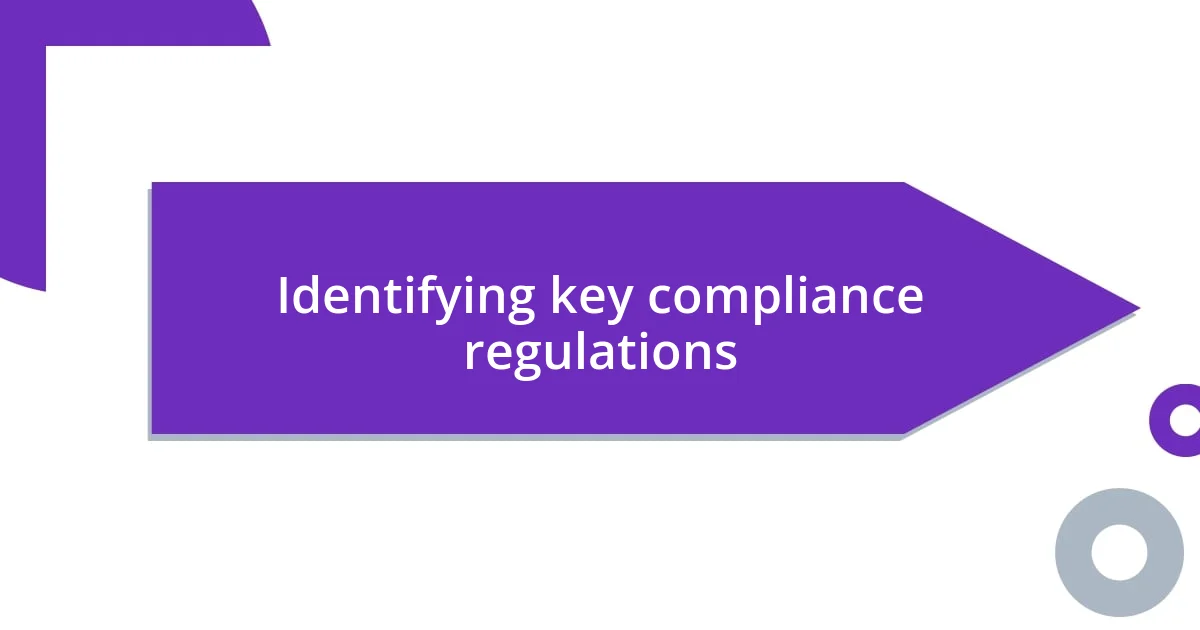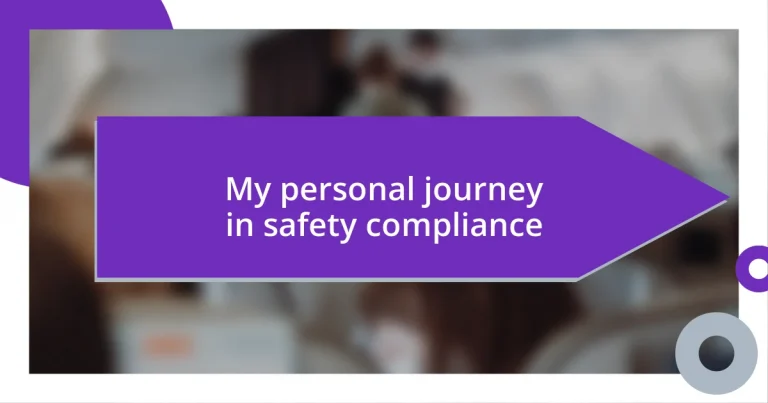Key takeaways:
- Establishing a positive safety culture and open communication enhances compliance and builds trust among team members.
- Regular self-assessments, feedback, and safety audits are critical for identifying knowledge gaps and reinforcing a commitment to safety practices.
- Ongoing education, networking, and adapting safety compliance strategies based on feedback and metrics are essential for continuous improvement and engagement.

Understanding safety compliance principles
Safety compliance principles are like the foundation of a building; without them, everything can come crashing down. I remember the first time I encountered a non-compliance issue in my workplace. The fear and uncertainty were palpable. It hit me hard—compliance isn’t just about meeting regulations; it’s about creating an environment where everyone feels safe and valued.
One critical aspect of safety compliance is the culture surrounding it. I often ask myself, “How can we foster a genuine culture of safety?” I’ve seen organizations that promote open communication, allowing employees to voice concerns without fear. This culture not only enhances compliance but also builds trust. It’s rewarding to witness shift changes where team members passionately discuss safety as part of their routine.
Another pivotal principle is the proactive approach to identifying hazards. From my experience, waiting for accidents to highlight gaps can be disastrous. I vividly recall a time when a simple risk assessment revealed potential dangers in our workspace, which we promptly addressed. Taking initiative not only prevented incidents but also empowered our team, reinforcing the idea that safety is everyone’s responsibility. Why wait for accidents to remind us how crucial these principles are?

Identifying key compliance regulations
Understanding compliance regulations is like learning the rules of a game; you can’t play effectively without knowing them. I still remember the tense moments during a compliance audit when every detail felt scrutinized. Discovering the key regulations relevant to your field can feel overwhelming, but breaking them down into manageable categories helps streamline the process.
- OSHA (Occupational Safety and Health Administration) standards are vital for workplace safety.
- EPA (Environmental Protection Agency) regulations focus on protecting the environment while ensuring safety compliance.
- ADA (Americans with Disabilities Act) mandates accessibility in the workplace, making it essential for inclusivity.
I’ve learned that the best way to identify these regulations is to prioritize ongoing education and collaboration with compliance experts. This journey often reminds me of the importance of being proactive rather than reactive; staying informed doesn’t just help avoid penalties—it creates a safer environment for everyone involved.

Assessing personal safety compliance skills
Assessing personal safety compliance skills is crucial in ensuring everyone acts according to established standards. I remember my first self-assessment; it was eye-opening. I thought I was doing well until I realized how much I didn’t know about hazard communication. This personal evaluation highlighted not just my weaknesses but also the areas I could strengthen, leading me to seek additional training. Each step in this journey illuminated a path toward becoming a more competent safety advocate.
In assessing compliance skills, I’ve learned the significance of feedback. When I gathered opinions from my colleagues about my safety practices, their insights were invaluable. Initially, it felt daunting to hear what I could improve upon, but ultimately, it reinforced my knowledge and commitment to safety. Such assessments are like a mirror; they reflect both our strengths and the potential we have to grow further.
Regularly practicing safety audits also sharpens personal compliance skills. I still conduct them at least quarterly, and it’s fascinating to see how my perception of risk evolves. One time, after an audit, I discovered a minor non-compliance that could have escalated into something severe. That experience taught me that ongoing self-assessment isn’t just a checkbox—it’s a mindset. Are we genuinely fostering safety, or just going through the motions?
| Method | Description |
|---|---|
| Self-Assessment | A personal evaluation of compliance skills to identify knowledge gaps and areas for improvement. |
| Feedback Gathering | Collecting insights from colleagues to enhance understanding and practices related to safety compliance. |
| Safety Audits | Conducting regular assessments of safety practices to ensure ongoing compliance and spot potential risks. |

Developing a safety compliance plan
Creating a safety compliance plan feels like piecing together a puzzle. One of my first experiences involved mapping out potential hazards in my workplace. I remember sitting with a team, brainstorming, and realizing that every voice contributed something vital. We prioritized the most critical risks, and that collective input not only shaped our plan but also bolstered team morale.
It’s easy to underestimate the emotional weight of this task. I recall feeling a mix of determination and anxiety when implementing our safety plan. Were we truly covering all aspects? Every meeting sparked a discussion about ongoing training and awareness. I learned that a safety compliance plan isn’t static; it evolves based on the feedback and input gathered over time. It’s a living document that requires nurture and attention to thrive.
In organizing our plan, I discovered the power of clarity. Each section outlined specific roles and responsibilities, which eased confusion during crises. How often do we assume everyone knows their part? I found that clearly defined responsibilities not only improved accountability but also fostered trust among team members. After all, when everyone understands their role in safety compliance, it’s like having a finely tuned orchestra—each person plays a critical note in creating a harmonious and safe environment.

Implementing safety practices effectively
Implementing safety practices effectively hinges on both proactive measures and a culture of openness. I recall a project where we introduced a new safety protocol. At first, the team was apprehensive about the change, fearing it might disrupt their routines. I encouraged open discussions, allowing everyone to voice their concerns and suggestions. This approach not only eased tensions but also led to key improvements we hadn’t initially considered, proving that collective input can enhance compliance significantly.
One critical aspect I’ve found is the importance of consistent training sessions. I remember attending a workshop meant to reinforce our safety culture. During that session, I felt a rush of motivation as I realized how much energy and knowledge could be exchanged. As I engaged with colleagues, the shared commitment became palpable. Have you ever felt that spark when everyone is geared up towards a common goal? It reinforced my belief that regular training not only keeps everyone informed but also cultivates a supportive network where safety practices take root organically.
I’ve also learned that recognizing and celebrating small successes can significantly impact the implementation of safety practices. One time, after a month of strict adherence to our safety protocols, we celebrated a “safety milestone.” It was a simple gathering, yet I noticed how proud everyone felt of their collective achievements. It made me think: how often do we pause to appreciate progress in our safety journey? By celebrating these victories, we foster a positive atmosphere that motivates everyone to continuously engage with safety practices, transforming compliance into a shared responsibility rather than a chore.

Evaluating compliance outcomes regularly
Regularly evaluating compliance outcomes is a critical piece of the safety puzzle that I’ve come to appreciate deeply. There was a time when we implemented a new safety measure, and initially, everything seemed to flow smoothly. But as I revisited our compliance outcomes weeks later, I noticed gaps that hadn’t been on my radar. This instilled in me the importance of not just occasional checks but ongoing assessments to ensure we didn’t become complacent.
I vividly recall a quarterly review meeting where team members shared their insights on compliance practices. The candid feedback stirred a lot of emotions; some felt proud, while others were anxious about missed opportunities. It highlighted for me the profound impact of these evaluations—not only do they reveal compliance levels, but they also foster a sense of accountability and shared responsibility among the team. Have you experienced that moment when feedback sparks a real shift in the group’s dynamic? It’s exhilarating to see how open dialogue can enrich our understanding and commitment to safety.
Furthermore, the idea of using metrics to gauge compliance outcomes truly transformed our approach. One of my favorite practices became the visual dashboards we created, displaying compliance stats in real-time. Watching those numbers shift with each new initiative created such excitement! It’s like a score in a game, and it kept everyone motivated. When was the last time you felt that rush of motivation from seeing tangible results? Regular evaluations turned those scores into personal victories for everyone involved, not just an abstract metric on paper.

Continuing education in safety compliance
Continuing education in safety compliance is something I’ve embraced as a vital part of my journey. I remember attending a specialized training course on emerging safety regulations. Initially, I thought it would be dull and repetitive, but the engaging discussions turned it into a vibrant exchange of ideas. I found myself reflecting on my own experiences and how they related to the new information. Have you ever discovered something that made you rethink your entire approach to a topic? It can be a game-changer.
One thing that struck me about ongoing education is its ability to bring fresh perspectives. After completing a certification in a new safety management system, I returned to my team buzzing with ideas. I shared insights I had learned and was met with enthusiasm rather than resistance. It was like we had rejuvenated our safety program together. How crucial is it to have this kind of invigorating dialogue in maintaining compliance? In my experience, it’s essential; it fosters a culture where learning and adaptation become second nature.
Networking plays a vital role, too. I recall a conference where I met industry experts who shared their innovations in safety practices. The conversations we had were eye-opening, each one sparking new thoughts on how to implement improvements back at work. It reinforced that education isn’t just about the material you learn; it’s about the connections you make and the inspiration you gain from others. Have you ever left an event feeling like your perspective had expanded? That’s the power of continued education in safety compliance—a shared journey of learning and growth.














